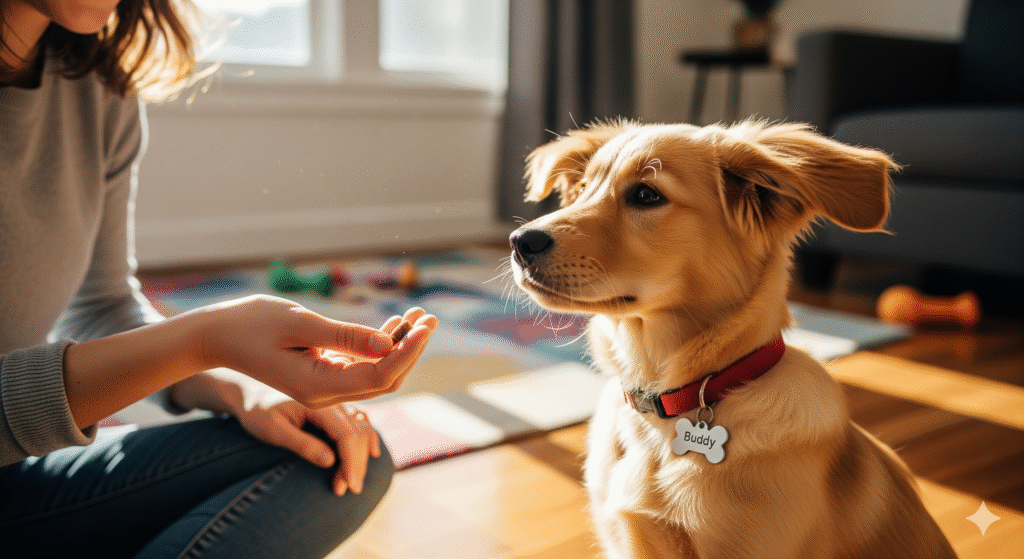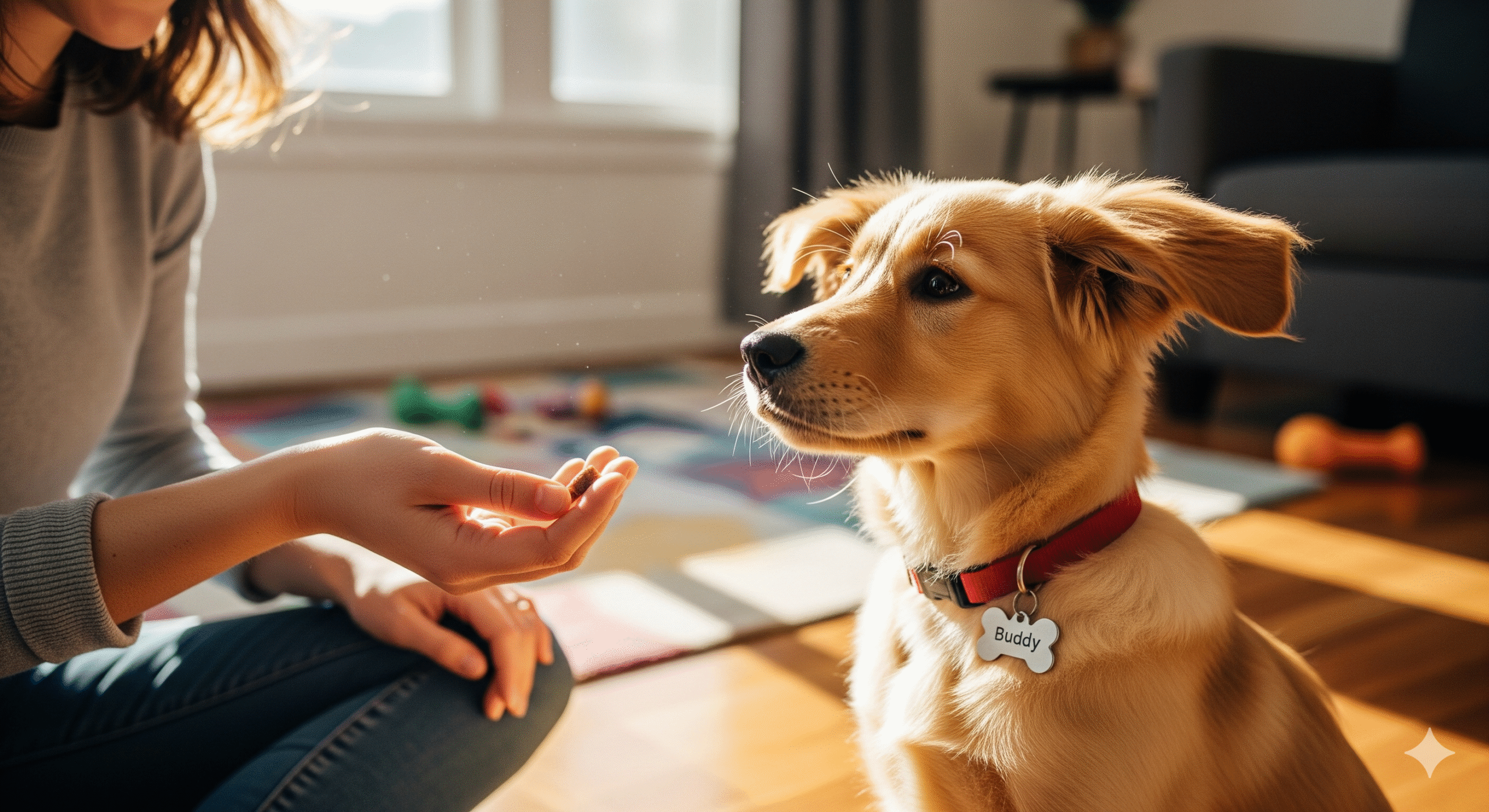The moment you choose your puppy’s name is magical. It’s the word that will define your bond, call them to safety, and get their attention for a lifetime of adventures. But how do you go from a cute label on a collar to a puppy who instantly turns their head when you call? Teaching your puppy its name is the single most important first lesson you will ever teach, and it sets the tone for all future training. 🎯
This isn’t about issuing a command; it’s about creating a powerful, positive association. A puppy who loves hearing their name is a puppy who is eager to listen and engage with you. This comprehensive puppy name recognition guide will walk you through the simple, science-backed steps to make your puppy’s name the most exciting sound in their world.
Why Name Recognition is Your Foundation for Everything 🧱
Before we dive into the “how,” let’s understand the “why.” A solid name response is the cornerstone of all communication with your dog.
- Safety First: A reliable name recall can stop your puppy in its tracks, preventing them from running into a dangerous situation like a busy street.
- Builds Focus: It teaches your puppy to voluntarily check in with you and break their focus from distractions.
- The Key to All Training: Every future command—”sit,” “stay,” “come”—starts with getting your puppy’s attention. Their name is the gateway.
- Strengthens Your Bond: This positive, reward-based process builds trust and makes you the center of your puppy’s universe.
What’s in a Name? Choosing the Right One 🏷️
If you haven’t settled on a name yet, a good choice can make training easier.
- Short & Sharp: Names with one or two syllables (e.g., Max, Luna, Bella, Cody) are easier for puppies to distinguish.
- Ending with a Vowel: Names that end in a long vowel sound (e.g., Chloe, Zoey, Leo) are easier to call out and tend to grab a dog’s attention better.
- Avoid Confusion: Steer clear of names that sound too much like common commands (e.g., “Kit” sounds like “sit,” “Ray” sounds like “stay”).
- Stick to One Name: Decide on one name and avoid using a million nicknames during the initial training phase. Consistency is key!
The Golden Rule: Make Your Puppy’s Name a Good Thing! 🌟
The entire goal of this process is to make your puppy think, “When I hear that sound, amazing things happen!” Never, ever use your puppy’s name for scolding or punishment. If you yell “Bella, NO!” when she has an accident, she will quickly learn that “Bella” predicts something bad and may start to avoid you when you call her.
Your puppy’s name should always mean:
- 🎉 TREATS!
- 🧸 PLAY!
- 🥰 PETTING & PRAISE!
- 🚶♂️ FUN WALKS!
Step 1: The Setup for Success 🎯
You’ll need:
- High-Value Treats: Small, soft, and smelly! Use something special like tiny pieces of boiled chicken, hot dog, or commercial training treats. This is not the time for their regular kibble.
- A Quiet Environment: Start indoors with no distractions. No TV, no other pets, no kids running around.
- Short Sessions: A puppy’s attention span is short. Aim for 2-3 minute sessions, 3-5 times a day.
Step 2: The Classic “Name Game” 🎮
This is the core exercise for building a positive association.
- Get Close: Sit with your puppy in a quiet room.
- Say Their Name: Clearly and happily say your puppy’s name ONE time. “Luna!”
- Immediate Reward: The instant they turn their head toward you—even slightly—mark the behavior with a “Yes!” or a click from a clicker, and immediately give them a treat.
- Repeat: Do this 5-10 times in a row. Keep it fun and fast-paced!
- End on a High: Quit while you’re ahead, before your puppy gets bored.
What if they don’t look? Don’t repeat their name. Instead, make a small kissy noise or gently tap the floor to get their attention. The second they look at you, say their name (“Yes, Luna!”) and give the treat. This still teaches them that looking at you when a sound happens is rewarding.
Step 3: Adding Movement and Distance 🏃♀️
Once your puppy is reliably whipping their head around to look at you when you say their name from a few feet away, it’s time to make it harder.
- Take a Step Back: Say their name from a step away. Reward the head turn.
- Move Around the Room: Practice calling their name when you’re standing up, when you’re kneeling, and when they are mildly distracted (e.g., sniffing the floor).
- The Recall Game: When they look at you after you call their name, take a few excited steps backward and encourage them to come to you. Reward them lavishly when they do! This begins to build the “come” command naturally.
Step 4: Proofing with Distractions 🌳
The final step is to practice in increasingly distracting environments. If you move too fast, your puppy will fail. Take it slow.
- Backyard: Practice in your quiet yard.
- Front Yard: Practice on-leash in your front yard with mild distractions (a car driving by, a person walking in the distance).
- Quiet Park: Take your puppy on-leash to a quiet park and practice. The “3 D’s” of dog training are Distance, Duration, and Distraction. Only ever increase one at a time.
Pro Tip: Always go back to using high-value treats in new, distracting environments. The value of the reward must match the difficulty of the task.
Troubleshooting Common Problems 🤔
- My puppy doesn’t respond with distractions: This is normal! You’ve moved too far too fast. Go back to a less distracting environment and practice more there. Make the reward even better.
- I’ve used the name for scolding: It’s time for a reboot! You may need to temporarily use a new nickname for a while as you rebuild the positive association with their original name using the Name Game.
- My puppy gets overexcited and jumps: If your puppy charges you and jumps up, you are likely rewarding too late. The reward should be for the head turn and focus, not the jumping. Try throwing the treat on the floor between their feet to keep them calm.
Beyond the Basics: Integrating Their Name into Life 🧩
Your puppy’s name shouldn’t just be for training sessions. Weave it into daily positive interactions.
- Say their name happily before you put their food bowl down.
- Say their name before you throw their favorite toy.
- Say their name before you give them a loving scratch behind the ears.
The Lifelong Reward 🏆
Teaching your puppy its name is an act of patience and love. By investing a few minutes each day in this simple, positive process, you are not just teaching a word; you are building a language of trust and cooperation that will last for years to come. A puppy who knows their name is a puppy who is connected, engaged, and ready to learn anything you want to teach them.
What’s your puppy’s name and how did they do with their training? Share your success stories and cute puppy photos in the comments below! 👇

“You’ve now found the perfect, durable, and comfortable bed that your puppy loves. But a bed isn’t just for sleeping! It can also be your most valuable training tool. Instead of your puppy following you around the kitchen or begging at the dinner table, you can teach them to relax on their bed on command. This transforms their bed from a piece of furniture into a key part of their training and daily routine. Ready to learn how? Put that new bed to great use by following our detailed guide on the Place Command for Puppies: Step-by-Step.”






